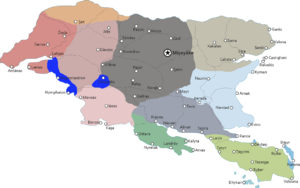Gylic languages
| Gylic | |
|---|---|
| Ethnicity | Gylic peoples |
| Geographic distribution | Siduri, Tyran |
| Linguistic classification | unclassified
|
| Proto-language | Proto-Gylic |
| Subdivisions |
|
 | |
The Gylic languages are a language family indigenous to Siduri and spoken primarily in Gylias. There is no consensus about what language families the Gylic family is related to, and various theories have been proposed.
Depending on classification scheme, there are either 2 or 4 branches of the Gylic language family, both based on geographic location.
Formerly written with various imported alphabets, the Gylic alphabet is now standard for writing Gylic languages.
Concept
"Gylic" is a modern term used to refer to the languages, by analogy with Gylic peoples. It is not to be confused with "Gylian", which includes all languages spoken in Gylias throughout history, independently of linguistic classification.
Proto-Gylic has been reconstructed to a sufficient extent to confirm it is the common ancestor of most Gylic languages. Other languages have been Gylicised or assimilated into the sprachbund.
There are sufficient key traits shared between Proto-Gylic and Paleo-Lemobrogic that linguists have proposed that the two are part of the same language family.
History
The origin of the Gylic languages is to an extent speculative. Most of the Gylic peoples originated in Siduri and migrated to the south-east.
The Yaskans and Zinerans were among the earliest Gylics to settle the region. The Yaskan language has been notably conservative, and linguists have relied heavily on it in reconstructing proto-Gylic.
The Gylic languages did not develop an indigenous writing system. Instead, from the introduction of writing, they borrowed and adapted existing alphabets, such as the Hellene alphabet, Latin alphabet, and runes. The Latin alphabet began to supersede the others in post-antiquity, and was standardised during the Gylian languages reform of 1958–1959.
The language family has been subject to various unifying and splitting factors throughout history, including the gap between the large total area and low population, the sustained contact engendered by the Liúşai League, contact with other peoples, and the Gylian ascendancy.
Linguistic model
Whether Gylic is a language family or a pluricentric language has been a contested issue since the Gylian ascendancy. The issue has strong political resonance, reflecting conventional Gylian nationalism (which emphasises multiculturalism and l'belle mosaïque) versus Gylicism (which advocates ethnic and cultural unity).
The Languages Board follows a model of treating Gylic as a language family, viewing the language–dialect distinction as arbitrary and subordinating.
Common features shared by the Gylic languages include the following:
- Phonotactics dominated by CV and CVC syllables. (VC syllables are more common in some Gylic languages than others.)
- The development of a strong stress on the first syllable of a word.
- Voiced and voiceless consonants, grouped in minimal pairs.
- Consonant clusters nearly entirely forbidden, except for sequences arising from two CVC syllables put together. The "floating y" is used to break up consonant clusters in loanwords and transliterations.
- Historical sound changes arising from loss of consonant clusters and elimination of certain consonant sequences.
- Limited number of vowels, some of which can become semivowels in diphthongs (namely /i/ → /j/ and /u/ or /ɨ/ → /w/).
- Morphology primarily isolating.
- Free syntactic order.
Modern characteristics introduced by the Gylian languages reform of 1958–1959 include the abolition of grammatical gender and T–V distinctions.
Classification
The traditional classification of the Gylic languages is by geographic location, mirroring that of the Gylic peoples. There are two principal schemes, which posit the existence of 2 or 4 branches of the language family.
Two branches
|
|
The central languages, Aréş and Aðunese, are considered "transitional" languages in this scheme.
One of the main distinctions between West and East Gylic languages comes from which foreign languages they have had greater influence from.
- West Gylic has a greater influence from Hellene as a result of the concentration of Hellene Gylians in Elena. West Gylic languages helped spread the use of -oi as a standard plural suffix, and tend towards subject–object–verb order.
- East Gylic has a greater influence from Italian due to contact with Cacerta and Megelan. East Gylic languages tend towards subject–verb–object order, and tend to turn /k/ sounds into /s/ sounds, a feature also present in Cacertian Italian.
This phenomenon is termed the "Hellene West and Italian East", or "Zephyros and Subsolanus" after the respective Hellene and Italian wind deities.
Four branches
|
|
|
|
The 4 branch scheme mirrors a common classification of the Gylic peoples. The model puts more emphasis on the differences along the north–south axis, and the assimilation of later-arrived groups.
Gylic koine
An early Gylic koine developed in the Liúşai League as a result of sustained interaction and admixture.
The Languages Board maintains a language policy based on linguistic maintenance and descriptivism. It also maintains a voluntary modern koine project.
Gylic koine word lists and proposed grammars are published to aid preservation of mutual intelligibility between Gylic languages without causing language shift.